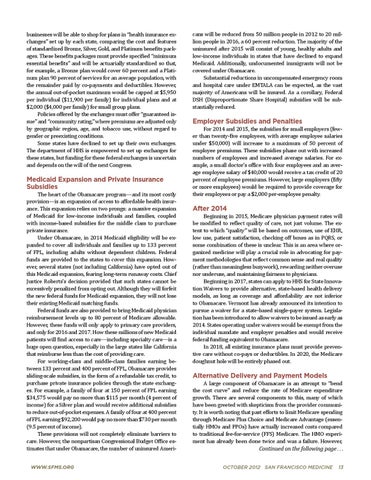businesses will be able to shop for plans in “health insurance exchanges” set up by each state, comparing the cost and features of standardized Bronze, Silver, Gold, and Platinum benefits packages. These benefits packages must provide specified “minimum essential benefits” and will be actuarially standardized so that, for example, a Bronze plan would cover 60 percent and a Platinum plan 90 percent of services for an average population, with the remainder paid by co-payments and deductibles. However, the annual out-of-pocket maximum would be capped at $5,950 per individual ($11,900 per family) for individual plans and at $2,000 ($4,000 per family) for small group plans. Policies offered by the exchanges must offer “guaranteed issue” and “community rating,” where premiums are adjusted only by geographic region, age, and tobacco use, without regard to gender or preexisting conditions. Some states have declined to set up their own exchanges. The department of HHS is empowered to set up exchanges for these states, but funding for these federal exchanges is uncertain and depends on the will of the next Congress.
Medicaid Expansion and Private Insurance Subsidies
The heart of the Obamacare program—and its most costly provision—is an expansion of access to affordable health insurance. This expansion relies on two prongs: a massive expansion of Medicaid for low-income individuals and families, coupled with income-based subsidies for the middle class to purchase private insurance. Under Obamacare, in 2014 Medicaid eligibility will be expanded to cover all individuals and families up to 133 percent of FPL, including adults without dependent children. Federal funds are provided to the states to cover this expansion. However, several states (not including California) have opted out of this Medicaid expansion, fearing long-term runaway costs. Chief Justice Roberts’s decision provided that such states cannot be excessively penalized from opting out. Although they will forfeit the new federal funds for Medicaid expansion, they will not lose their existing Medicaid matching funds. Federal funds are also provided to bring Medicaid physician reimbursement levels up to 80 percent of Medicare allowable. However, these funds will only apply to primary care providers, and only for 2016 and 2017. How these millions of new Medicaid patients will find access to care—including specialty care—is a huge open question, especially in the large states like California that reimburse less than the cost of providing care. For working-class and middle-class families earning between 133 percent and 400 percent of FPL, Obamacare provides sliding-scale subsidies, in the form of a refundable tax credit, to purchase private insurance policies through the state exchanges. For example, a family of four at 150 percent of FPL earning $34,575 would pay no more than $115 per month (4 percent of income) for a Silver plan and would receive additional subsidies to reduce out-of-pocket expenses. A family of four at 400 percent of FPL earning $92,200 would pay no more than $730 per month (9.5 percent of income). These provisions will not completely eliminate barriers to care. However, the nonpartisan Congressional Budget Office estimates that under Obamacare, the number of uninsured Ameriwww.sfms.org
cans will be reduced from 50 million people in 2012 to 20 million people in 2016, a 60 percent reduction. The majority of the uninsured after 2015 will consist of young, healthy adults and low-income individuals in states that have declined to expand Medicaid. Additionally, undocumented immigrants will not be covered under Obamacare. Substantial reductions in uncompensated emergency room and hospital care under EMTALA can be expected, as the vast majority of Americans will be insured. As a corollary, Federal DSH (Disproportionate Share Hospital) subsidies will be substantially reduced.
Employer Subsidies and Penalties
For 2014 and 2015, the subsidies for small employers (fewer than twenty-five employees, with average employee salaries under $50,000) will increase to a maximum of 50 percent of employee premiums. These subsidies phase out with increased numbers of employees and increased average salaries. For example, a small doctor’s office with four employees and an average employee salary of $40,000 would receive a tax credit of 20 percent of employee premiums. However, large employers (fifty or more employees) would be required to provide coverage for their employees or pay a $2,000 per-employee penalty.
After 2014
Beginning in 2015, Medicare physician payment rates will be modified to reflect quality of care, not just volume. The extent to which “quality” will be based on outcomes, use of EHR, low use, patient satisfaction, checking off boxes as in PQRS, or some combination of these is unclear. This is an area where organized medicine will play a crucial role in advocating for payment methodologies that reflect common sense and real quality (rather than meaningless busywork), rewarding neither overuse nor underuse, and maintaining fairness to physicians. Beginning in 2017, states can apply to HHS for State Innovation Waivers to provide alternative, state-based health delivery models, as long as coverage and affordability are not inferior to Obamacare. Vermont has already announced its intention to pursue a waiver for a state-based single-payer system. Legislation has been introduced to allow waivers to be issued as early as 2014. States operating under waivers would be exempt from the individual mandate and employer penalties and would receive federal funding equivalent to Obamacare. In 2018, all existing insurance plans must provide preventive care without co-pays or deductibles. In 2020, the Medicare doughnut hole will be entirely phased out.
Alternative Delivery and Payment Models
A large component of Obamacare is an attempt to “bend the cost curve” and reduce the rate of Medicare expenditure growth. There are several components to this, many of which have been greeted with skepticism from the provider community. It is worth noting that past efforts to limit Medicare spending through Medicare Plus Choice and Medicare Advantage (essentially HMOs and PPOs) have actually increased costs compared to traditional fee-for-service (FFS) Medicare. The HMO experiment has already been done twice and was a failure. However,
Continued on the following page . . .
October 2012 San Francisco Medicine
13
